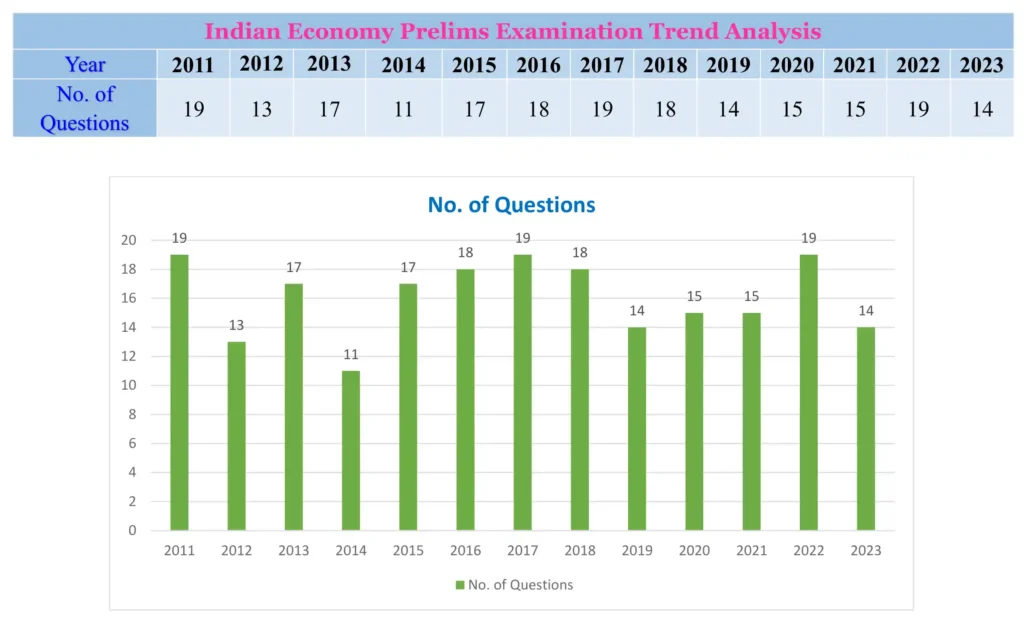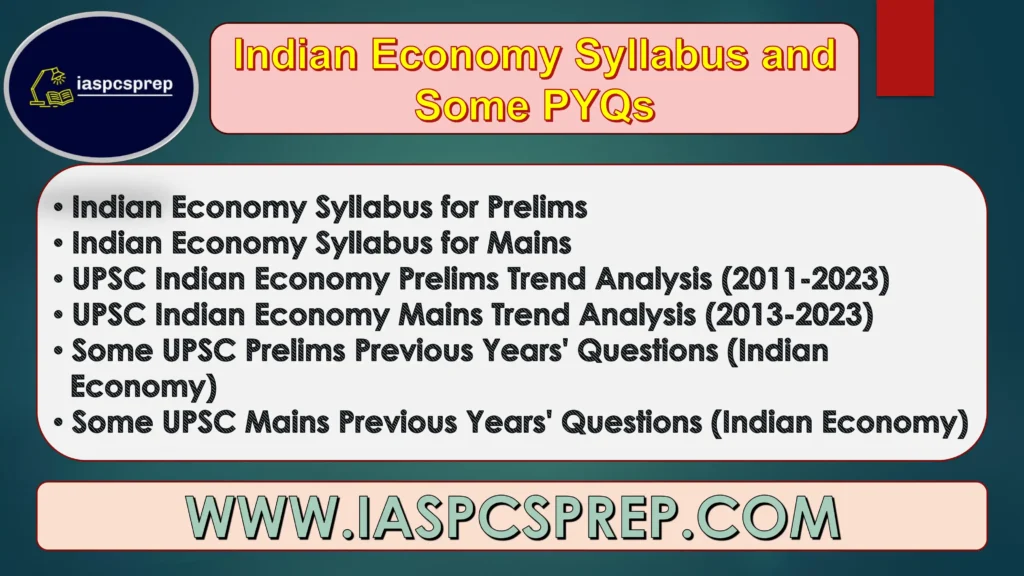| Indian Economy Syllabus and Some PYQs |
The link of PDF of this Indian Economy Syllabus is given below the explanation of the class, you can download the PDF by going below.
Indian Economy Syllabus and Some PYQs
In this post of “Indian Economy Syllabus”, we will discuss about the Syllabus of Indian Economy for Prelims and Mains, UPSC Indian Economy Trend Analysis for Prelims and Mains, Some Previous Years UPSC Indian Economy Questions for Prelims and Mains etc.
Syllabus for UPSC Prelims (Indian Economy):
- Economic and Social Development – Sustainable Development, Poverty, Inclusion, Demographics, Social Sector Initiatives, etc.
Syllabus for UPSC Mains (Indian Economy):
- Indian Economy and issues relating to planning, mobilization, of resources, growth, development, and employment.
- Inclusive growth and issues arising from it.
- Government Budgeting.
- Major crop-cropping patterns in various parts of the country, – different types of irrigation and irrigation systems storage, transport, and marketing of agricultural produce and issues and related constraints; e-technology in the aid of farmers.
- Issues related to direct and indirect farm subsidies and minimum support prices; Public Distribution System- objectives, functioning, limitations, revamping; issues of buffer stocks and food security; Technology missions; economics of animal-rearing.
- Food processing and related industries in India- scope’ and significance, location, upstream and downstream requirements, supply chain management.
- Land reforms in India.
- Effects of liberalization on the economy, changes in industrial policy, and their effects on industrial growth.
- Infrastructure: Energy, Ports, Roads, Airports, Railways etc.
- Investment models.
UPSC Indian Economy Trend Analysis (Prelims)

UPSC Indian Economy Trend Analysis (Mains)

Some Previous Years’ UPSC Prelims Questions (Indian Economy)
Q1. Karl Marx explained the process of class struggle with the help of which one of the following theories? (2011)
a) Empirical Liberalism
b) Existentialism
c) Darwin’s theory of evolution
d) Dialectical materialism
Q2. The Reserve Bank of India (RBI) acts as a bankers’ bank. This would imply which of the following? (2012)
1. Other banks retain their deposits with the RBI.
2. The RBI lends funds to the commercial banks in times of need.
3. The RBI advises the commercial banks on monetary matters.
Select the correct answer using the code given below:
a) 2 and 3 only
b) 1 and 2 only
c) 1 and 3 only
d) 1, 2 and 3
Q3. The balance of payments of a country is a systematic record of (2013)
a) all import and export transactions of a country during a given period of time, normally a year.
b) goods imported from a country during a year.
c) economic transaction between the government of one country to another.
d) capital movements from one country to another country.
Q4. What does venture capital mean? (2014)
a) A short-term capital provided to industries.
b) A long-term start-up capital provided to new entrepreneurs.
c) Funds provided to industries at times of incurring losses.
d) Funds provided for replacement and renovation of industries.
Q5. With reference to Indian economy, consider the following: (2015)
1. Bank rate
2. Open Market Operations
3. Public Debt
4. Public Revenue
Which of the above is/are component/components of Monetary Policy?
a) 1 only
b) 2, 3 and 4
c) 1 and 2
d) 1, 3 and 4
Q6. Which of the following is/are included in the capital budget of the Government of India? (2016)
1. Expenditure on acquisition of assets like roads, buildings, machinery etc.
2. Loans received from foreign governments.
3. Loans and advances granted to the State & Union Territories.
Select the correct answer using the code given below:
a) 1 only
b) 2 and 3 only
c) 1 and 3 only
d) 1, 2 and 3
Q7. What is the purpose of setting up of Small Finance Banks (SFBS) in India? (2017)
1. To supply credit to small business units.
2. To supply credit to small and marginal farmers.
3. To encourage young entrepreneurs to set up business particularly in rural areas.
Select the correct answer using the cade given below:
a) 1 and 2 only
b) 2 and 3 only
c) 1 and 3 only
d) 1, 2 and 3
Q8. Consider the following statements: (2018)
Human Capital formation as a concept is better explained in terms of a process which enables
1. Individuals of a country to accumulate more capital.
2. Increasing the knowledge, skill level and capacities of the people of the country.
3. accumulation of tangible wealth.
4. accumulation of intangible wealth.
Which of the statements given above is/are correct?
a) 1 and 2
b) 2 only
c) 2 and 4
d) 1, 3 and 4
Q9. Consider the following statements: (2019)
1. Purchasing Power Parity (PPP) exchange rates are calculated by comparing the prices of the same basket of goods and services in different countries.
2. In terms of PPP dollars, India is the sixth largest economy in the world.
Which of the statements given above is/are correct?
a) 1 only
b) 2 only
c) Both 1 and 2
d) Neither 1 nor 2
Q10. Consider the following statements: (2020)
1. The weightage of food in Consumer Price Index (CPI) is higher than that in Wholesale Price Index (WPI).
2. The WPI does not capture changes in the prices of services, which CPI does.
3. Reserve Bank of India has now adopted WPI as its key measure of inflation and to decide on changing the key policy rates.
Which of the statements given above is/are correct?
a) 1 and 2 only
b) 2 only
c) 3 only
d) 1, 2 and 3
Q11. Consider the following statements: (2021)
Other things remaining unchanged, market demand for a good might increase if
1. Price of its substitute increases
2. Price of its complement increases.
3. the good is an inferior good and income of the consumers increases.
4. its price falls.
Which of the above statements are correct?
a) 1 and 4 only
b) 2, 3 and 4
c) 1, 3 and 4
d) 1, 2 and 3
Q12. With reference to Indian economy, consider the following statements: (2022)
1. If the inflation is too high, Reserve Bank of India (RBI) is likely to buy government securities.
2. If the rupee is rapidly depreciating, RBI is likely to sell dollars in the market.
3. If interest rates in the USA or European Union were to fall, that is Likely to induce RBI to buy dollars.
Which of the statements given above are correct?
a) 1 and 2 only
b) 2 and 3 only
c) 1 and 3 only
d) 1, 2 and 3
Q13. Consider the following statements with reference to India: (2023)
1. According to the ‘Micro, Small and Medium Enterprises Development (MSMED) Act, 2006’, the ‘medium enterprises’ are those with investments in plant and machinery between ₹ 15 crore and ₹ 25 crore.
2. All bank loans to the Micro, Small and Medium Enterprises qualify under the priority sector.
Which of the statements given above is/are correct?
a) 1 only
b) 2 only
c) Both 1 and 2
d) Neither 1 nor 2
Some Previous Years’ UPSC Mains Questions (Indian Economy)
Q1. Discuss the rationale for introducing Goods and Services Tax (GST) in India. Bring out critically the reasons for the delay in roll out for its regime. (200 Words) [10 Marks] (2013)
Q2. Capitalism has guided the world economy to unprecedented prosperity. However, it often encourages short-sightedness and contributes to wide disparities between the rich and the poor. In this light, would it be correct to believe and adopt capitalism for bringing inclusive growth in India? Discuss. (250 Words) [12.5 Marks] (2014)
Q3. There is a clear acknowledgement that Special Economic Zones (SEZs) are a tool of industrial development, manufacturing and exports. Recognizing this potential, the whole instrumentality of SEZs require augmentation. Discuss the issues plaguing the success of SEZs with respect to taxation, governing laws and administration. (200 Words) [12.5 Marks] (2015)
Q4. Justify the need for FDI for the development of the Indian economy. Why there is gap between MOUs signed and actual FDIs? Suggest remedial steps to be taken for increasing actual FDIs in India. (200 Words) [12.5 Marks] (2016)
Q5. “Industrial growth rate has logged-behind in the overall growth of Gross Domestic Product (GDP) in the post-reform period.” Give reasons. How far the recent changes in Industrial-Policy are capable of increasing the industrial growth rate? (Answer in 250 Words) [15 Marks] (2017)
Q6. How are the principles followed by the NITI Aayog different from those followed by the erstwhile Planning Commission in India? (Answer in 250 Words) [15 Marks] (2018)
Q7. The public expenditure management is a challenge to the Government of India in the context of budget making during the post-liberalization period. Clarify it. (Answer in 250 Words) [15 Marks] (2019)
Q8. Explain the meaning of investment in an economy in terms of capital formation. Discuss the factors to be considered while designing a concession agreement between a public entity and a private entity. (Answer in 250 Words) [15 Marks] (2020)
Q9. Do you agree that the Indian economy has recently experienced V-shaped recovery? Give reasons in support of your answer. (Answer in 250 Words) [15 Marks] (2021)
Q10. Why is Public Private Partnership (PPP) required in infrastructural projects? Examine the scale of PPP model in the redevelopment of Railway Stations in India. (Answer in 150 Words) [10 Marks] (2022)
Q11. Most of the unemployment in India is structural in nature. Examine the methodology adopted to compute unemployment in the country and suggest improvements. (Answer in 250 Words) [15 Marks] (2023)
| Some Important Links | |
| Download Indian Economy Syllabus PDF | Click Here |
| If you are satisfied with our website iaspcsprep.com, Please like and share with more people. | |
| Follow on Instagram | Follow Now |
| Join WhatsApp Group for PDF | Join Now |
| For any Query and Feedback, Contact Us at – study@iaspcsprep.com. | |


Related Posts:


